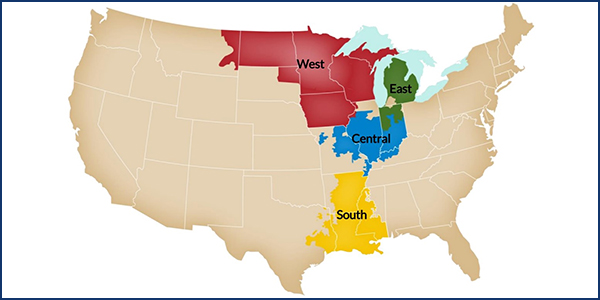MISO West won’t be the site of pricey buildouts in this year’s transmission planning cycle, despite complaints from critics that renewables in the region’s interconnection queue necessitate billions in grid upgrades.
“We don’t have any super big-ticket projects for the West this year,” MISO Manager of Expansion Planning Zheng Zhou said at a June 2 subregional planning conference call for the region, which includes Minnesota, Iowa, parts of the Dakotas and western Wisconsin.
Transmission owners in MISO West proposed 145 new projects for about $910 million in the 2020 Transmission Expansion Plan (MTEP 20), which so far contains 510 proposed projects at a combined $4.06 billion.
The costliest is American Transmission Co.’s $40 million Arcadian power transformer upgrade project in southeast Wisconsin, proposed because of the age and condition of the existing equipment.
But no projects in the West region were among the top 10 most expensive, currently found in MISO’s Central and South regions. (See Price Tag Rising for MTEP 20.)
At the same time, the West region is showing the need for billions in transmission investment to accommodate new generation projects, based on the makeup of MISO’s interconnection queue.
The April 2018 cycle of 35 projects at 4.7 GW shows the need for a total $1.1 billion in network upgrades, before affected-system network upgrades are factored in. The August 2017 cycle of about 4.1 GW in 27 projects also needs about $1.1 billion in transmission upgrades.
Stakeholders have argued that MISO West is neglected in terms of new transmission capacity, which they say has led to prohibitively expensive network upgrades and stifled proposed renewable generation projects.
MISO is currently processing six cycles of West interconnection requests dating to 2017. The interconnection queue currently contains 434 projects totaling 67.4 GW, enough capacity to cover a little more than half of MISO’s peak load. More than 60 generation projects have dropped out of the queue so far this year, while about 30 have completed generator interconnection agreements.
Revealing Overlap
MISO also announced it has identified 313 reliability issues in need of solutions in the West service areas of Northern States Power, Central Minnesota Municipal Power Agency, Minnesota Municipal Power Agency, Minnesota Power, Otter Tail Power and Minnkota Power Cooperative.
Most of those reliability issues are not covered by proposals submitted for MTEP 20. MISO said it will continue assessing the likelihood for contingencies and announce any additional transmission needs during the next West subregional planning meeting in August.
The RTO has pledged to address the increasing cost of network upgrades in its interconnection queue by linking its annual transmission planning process with network upgrade planning. The synchronization could result in MISO approving more transmission projects; however, those changes will begin with MTEP 21, not MTEP 20. (See MISO Floats Ideas on MTEP, Interconnection Coupling.)
Zhou said MISO cannot yet confidently select a project that handles overlapping economic, reliability and generator interconnection needs because so many proposed generation projects drop out of the queue.
Clean Grid Alliance’s Natalie McIntire said she understands MISO doesn’t have a process in place for combining reliability, economic and network upgrade projects, but she asked the RTO to be more forthcoming about projects that could potentially be merged.
“Maybe we can be a little more transparent and bring this process out into the open,” she said.
MISO says it will begin publishing new regional planning maps that show possible economic, reliability and generator interconnection needs on the same chart.
“We wanted a more holistic map of issues,” expansion planning engineer David Ticknor explained to stakeholders. “This will hopefully allow us to coordinate and collaborate on holistic solutions … in planning cycles going forward.”
Ticknor said the new maps will be updated periodically and contain indicators for generator interconnection thermal constraints, MTEP reliability constraints and congested flowgates that are possibly ripe for an MTEP economic project.
Ticknor said, for now, the maps will be educational and not used to propose transmission solutions.
“How are we going to move past the educational piece to use these maps for consolidated projects?” McIntire asked.
Ticknor said MISO will also begin internal and stakeholder discussions on project overlaps its planners have observed. “We figured starting off with a map was the easiest way to start a conversation about how things can work moving forward,” he said.
Sustainable FERC Project’s Lauren Azar asked if MISO is actively monitoring transmission assets that might be ripe for age and condition-related upgrades so it might find opportunities to consolidate project types even further.
Ticknor said MISO doesn’t currently ask TOs for a list of impending upgrades to aging equipment but that it could look into maintaining such a list.





